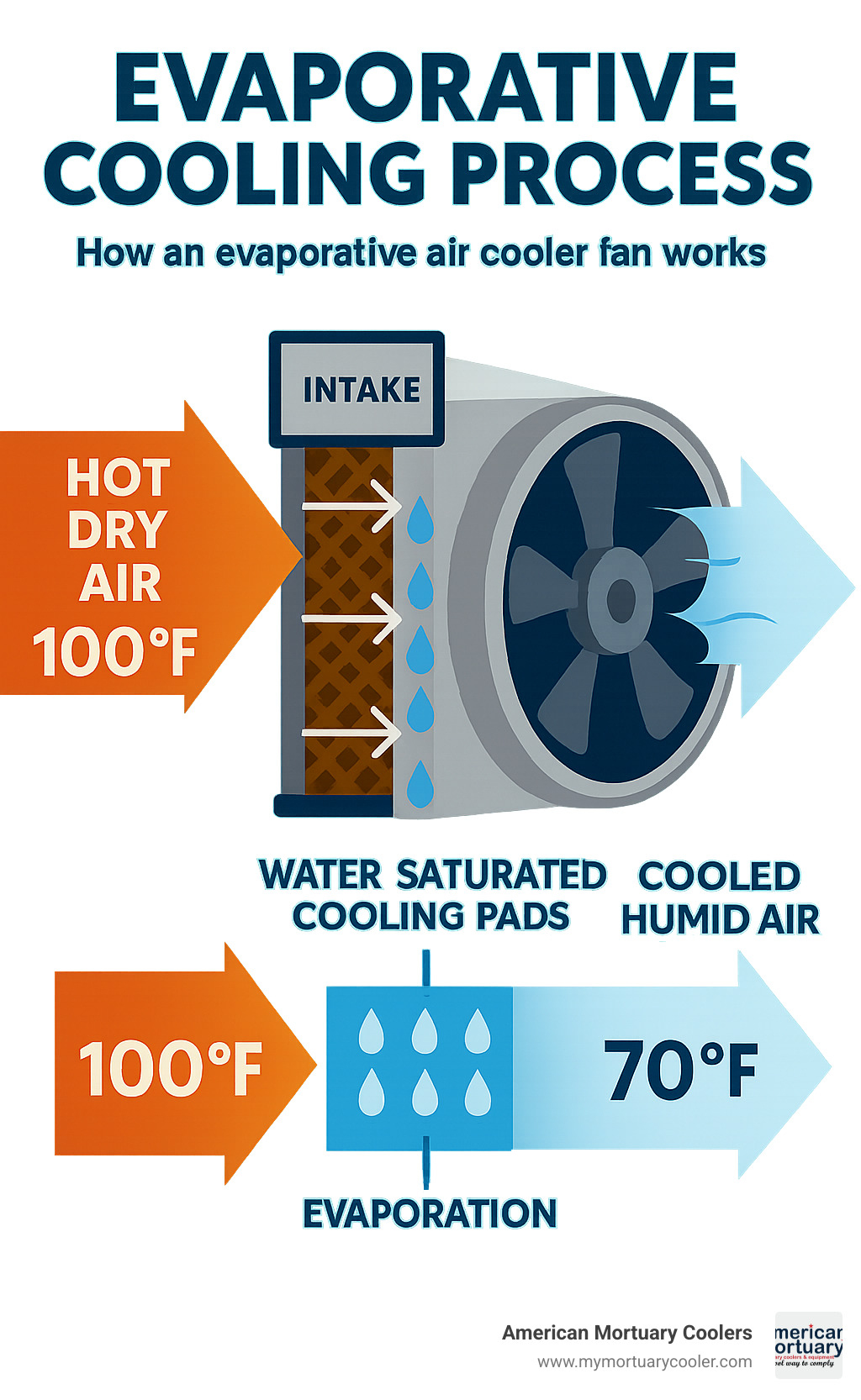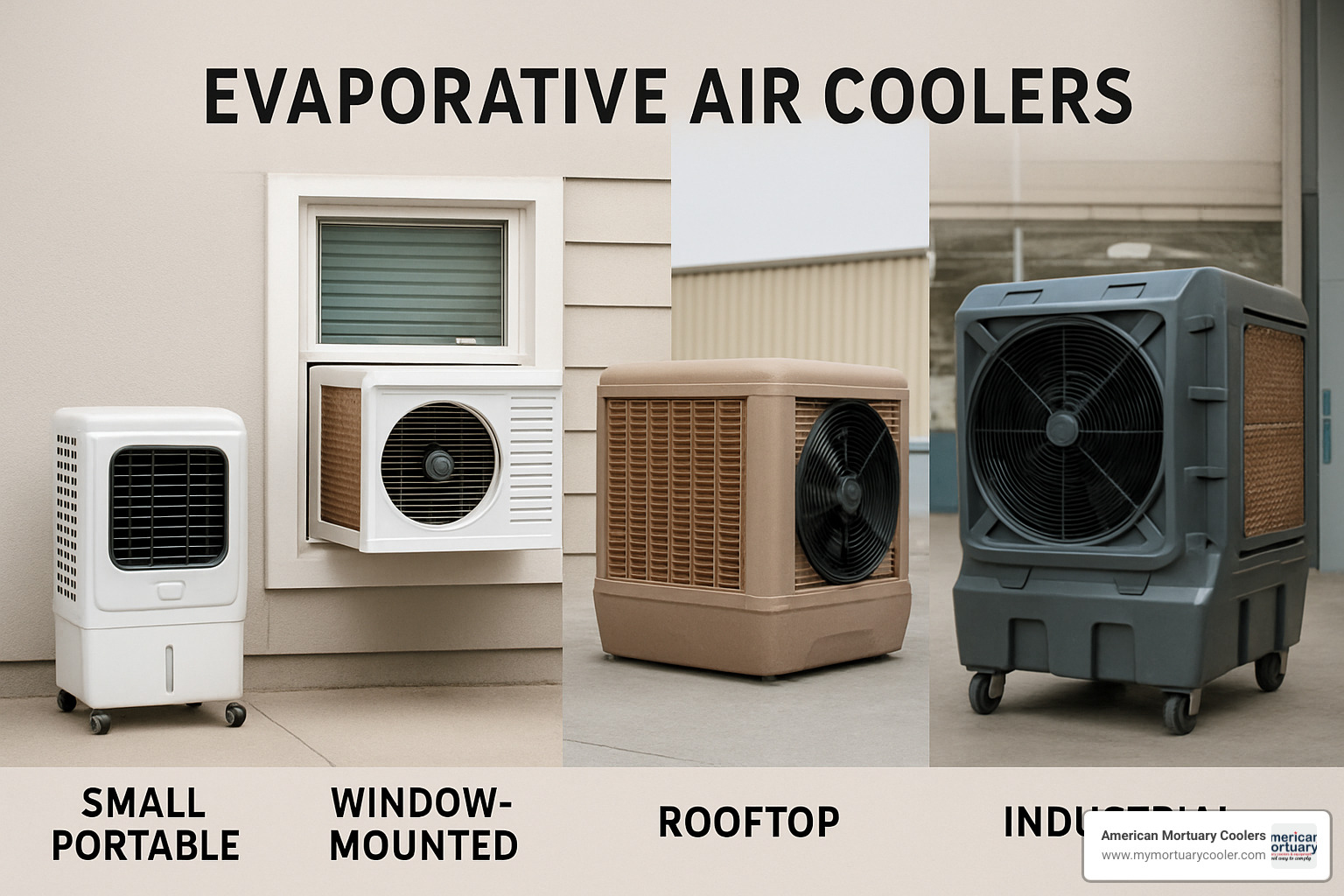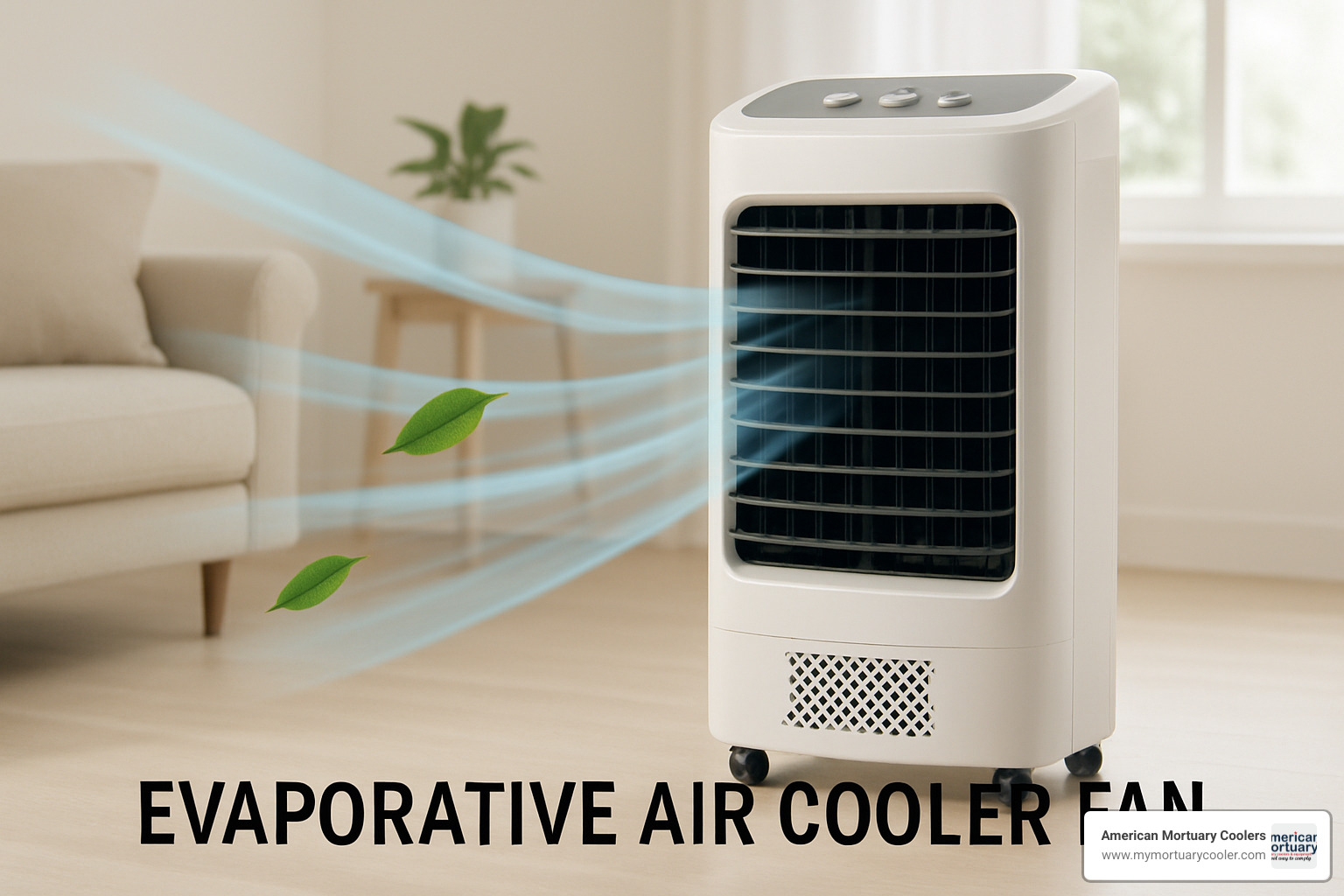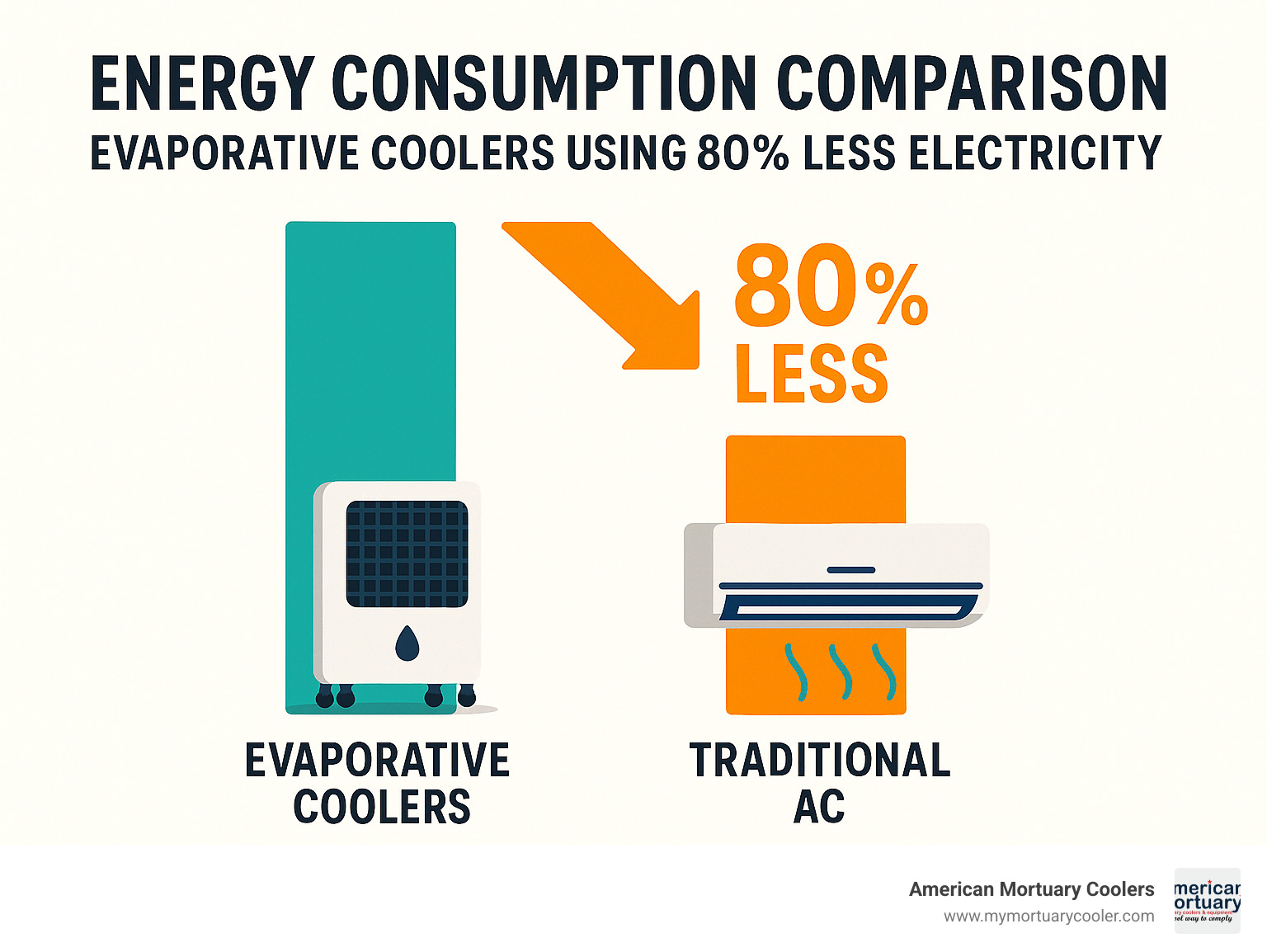Why Evaporative Air Cooler Fans Are Revolutionizing Energy-Efficient Cooling
An evaporative air cooler fan is a cooling device that uses water evaporation to lower air temperature while circulating fresh air through your space. Unlike traditional air conditioners that use refrigerants and compressors, these units work by drawing hot air through water-saturated pads, where evaporation naturally cools the air by up to 30°F.
Quick Overview of Evaporative Air Cooler Fans:
- How they work: Fan pulls hot air through wet pads, evaporation cools the air
- Energy savings: Use up to 80% less electricity than traditional AC units
- Best climates: Hot, dry regions with low humidity (under 70% relative humidity)
- Coverage: Range from 350 sq ft portable units to 6,500+ sq ft industrial models
- Water usage: About 4 gallons per day vs 67 gallons for typical household showers
- Cost: $100-$5,000 depending on size and features
These cooling systems excel in arid climates where they can drop ambient temperatures significantly while adding beneficial moisture to dry air. They consume 100 times less power than regular AC systems and provide complete air changes every two minutes, delivering fresh outdoor air instead of recirculating stale indoor air.
However, they're less effective in humid environments where the air is already saturated with moisture, limiting the evaporation process that creates the cooling effect.
I'm Mortuary Cooler, a national-level supplier specializing in commercial cooling solutions including evaporative air cooler fan systems for funeral homes and mortuary facilities. With years of experience helping facilities choose the right cooling equipment, I understand the critical balance between energy efficiency, reliability, and performance that professional environments demand.

Essential evaporative air cooler fan terms:
What Is an Evaporative Air Cooler Fan & How It Works
Think about how refreshed you feel when a cool breeze hits your skin on a hot day. That's essentially how an evaporative air cooler fan works—it uses the same natural process that cools your body when you sweat.
The science is beautifully simple. When water changes from liquid to vapor, it absorbs energy (called latent heat) from the surrounding air. This naturally lowers the temperature around it. Latest research on evaporative cooling shows just how powerful this process is—one gallon of evaporated water can remove up to 8,000 BTUs of heat from the air.
Here's where the engineering magic happens. An evaporative air cooler fan pulls hot, dry air through water-saturated cooling pads using a powerful fan motor. As the airflow passes through these wet pads, water evaporates and absorbs heat energy, creating a steady stream of cooled, humidified air that gets circulated throughout your space.
The effectiveness depends heavily on something called wet-bulb temperature—basically the lowest temperature you can achieve through evaporation at your current humidity levels. The drier and hotter the incoming air, the more dramatic the cooling effect.
Key Components of an Evaporative Air Cooler Fan
Every evaporative air cooler fan relies on five essential components working together.
The housing forms the protective outer shell that directs airflow and protects internal components. Quality units feature corrosion-resistant materials like powder-coated steel or UV-resistant plastics.
At the heart of the system are the media pads—specialized materials like aspen wood fiber, cellulose, or synthetic media that maximize surface area for water contact. These pads need to stay perfectly saturated to maintain optimal evaporation rates.
The reservoir holds water—typically anywhere from 4 to 65 gallons depending on the unit size. A float valve maintains proper water levels automatically.
The fan and motor assembly moves large volumes of air through those wet pads. CFM (cubic feet per minute) ratings range from 1,300 CFM in portable units to over 30,000 CFM in industrial powerhouses.
Modern control panels feature digital displays, timers, remote controls, and even smart connectivity. Advanced models include humidity sensors, water level indicators, and automatic shutoff features.
Evaporative Cooling vs. Traditional Air Conditioning
The differences between evaporative cooling and traditional AC go far beyond just the cooling method. Traditional air conditioners use complex vapor-compression cycles with chemical refrigerants and energy-hungry compressors.
Evaporative air cooler fans take a completely different approach. They use up to 80% less energy than traditional AC units, which can translate to dramatically lower utility bills.
| Feature | Evaporative Cooling | Traditional AC |
|---|---|---|
| Energy Use | 10-20% of AC power | High compressor energy |
| Operating Cost | Up to 80% savings | Standard utility rates |
| Environmental Impact | No refrigerants | Uses chemical refrigerants |
| Air Quality | 100% fresh outdoor air | Recirculates indoor air |
| Humidity Effect | Adds moisture | Removes moisture |
| Installation | Portable or simple setup | Complex ductwork/mounting |
| Maintenance | Clean pads, refill water | Professional service required |
Perhaps the biggest difference is air quality. Evaporative air cooler fans deliver continuous fresh air changes—completely replacing indoor air every two minutes. Traditional AC systems recirculate the same stale indoor air over and over.
Benefits and Limitations of Evaporative Air Cooler Fans
The most eye-catching advantage is energy savings. We're talking about up to 80% lower electricity bills compared to traditional air conditioning. While your neighbor's AC unit is guzzling power, your evaporative cooler sips electricity. Personal units use as little as 7-10 watts, while even large industrial models consume dramatically less energy than comparable AC systems.
Here's where the science gets interesting: one gallon of evaporated water removes 8,000 BTUs of heat from the air. And unlike AC systems that fight against nature with energy-hungry compressors and chemical refrigerants, evaporative cooling works with natural processes.
The environmental benefits are equally impressive. Scientific research on eco-friendly cooling confirms these systems as one of the most sustainable cooling solutions available. No synthetic refrigerants means no ozone depletion concerns and a significantly smaller carbon footprint.
Despite literally using water to cool your space, these systems are remarkably efficient. A typical evaporative air cooler fan uses about 4 gallons per day—that's less water than a family of four uses taking 7-minute showers.
The fresh air exchange is another game-changer. While AC systems recirculate the same stale indoor air, evaporative coolers provide 100% fresh outdoor air, completely replacing your indoor air every two minutes. Built-in filtration removes dust, pollen, and airborne particles while adding beneficial moisture to dry environments.
Now, let's talk about the reality check. Evaporative air cooler fans aren't magic, and they definitely have limitations that matter.
Climate suitability is the big one. When relative humidity climbs above 70%, the cooling effect drops dramatically because the air simply can't absorb much additional moisture.
The humidity effect can work against you in already humid climates or poorly ventilated spaces. These systems add moisture to indoor air, which sounds great in Arizona but not so much in Louisiana during summer.
Water quality becomes an issue in areas with hard water. Mineral buildup on pads and components means more frequent maintenance. Noise levels can also be higher than traditional AC units.
When They Shine—and When They Don't
Evaporative air cooler fans are absolute superstars in dry regions like the southwestern United States. Cities like Phoenix, Las Vegas, Denver, and Albuquerque provide ideal conditions where these systems can drop temperatures by 20-30°F consistently.
They excel in well-ventilated spaces with adequate air exchange, outdoor cooling for patios and workshops, industrial facilities needing fresh air circulation, and as supplemental cooling alongside existing systems.
But even desert dwellers face challenges during monsoon season. When humidity spikes, even the driest climates can see reduced effectiveness. Indoor humidity becomes a concern in sealed spaces without proper ventilation.
The bottom line? These systems shine brightest when humidity stays below 50% and you have good airflow.
Types, Sizing & Buying Guide
Shopping for an evaporative air cooler fan can feel overwhelming with so many options available. Once you understand the main categories, finding the perfect unit becomes much simpler.
Portable units are the crowd favorites for good reason. These wheeled workhorses typically deliver 1,300-5,300 CFM and can cool anywhere from 350 square feet up to 1,600 square feet. Just plug them into any standard outlet, add water, and you're cooling—no installation headaches required.
Window coolers work like traditional window AC units but use evaporative cooling instead. They're perfect when you want dedicated room cooling without sacrificing floor space.
For whole-house cooling, rooftop swamp coolers connect to your existing ductwork and can handle 2,000+ square feet. They require professional installation but can cool your entire home through the same vents your heater uses.
Then there are the industrial giants—massive units pumping out 10,000-30,000+ CFM for warehouses, factories, and large commercial spaces. At American Mortuary Coolers, we've helped funeral homes choose these larger units for their preparation areas where consistent, powerful cooling is essential.

Check out our Ultimate Checklist for Choosing the Best Portable Air Cooler for detailed selection guidance.
Choosing the Right Type for Your Space
Garage workshops do great with portable units delivering 3,000-5,000 CFM. Look for sturdy construction that can handle sawdust and occasional bumps.
Patios and outdoor entertaining areas need serious airflow since you're fighting the open sky. High-CFM portable units (5,000+ CFM) work well, especially models with weather-resistant construction.
Warehouses and industrial facilities require the big guns—stationary units with 10,000+ CFM capacity. Three-phase power units run more efficiently and cost less to operate than single-phase alternatives.
Office spaces need a balance between cooling power and noise levels. Medium-sized portable units (2,000-4,000 CFM) usually hit the sweet spot.
Properly Sizing an Evaporative Air Cooler Fan
Getting the size right makes the difference between comfortable cooling and disappointing performance. The math isn't complicated, but it's important to get it right.
Start with your room's cubic footage: length × width × ceiling height. A 500 square foot room with 10-foot ceilings gives you 5,000 cubic feet to cool. For moderate cooling in average conditions, you'll need about half that number in CFM—so around 2,500 CFM minimum.
Climate makes a huge difference. In bone-dry desert climates, that same room might cool beautifully with just 2,500 CFM. In more humid areas, you might need 4,000-5,000 CFM to achieve the same comfort level.
Must-Have Features & Nice-to-Haves
Variable speed control tops the must-have list—you'll want to adjust airflow based on conditions and noise tolerance. Water level indicators prevent the disaster of running dry, which can damage pads and motors.
Drain valves make maintenance and seasonal storage much easier. Caster wheels seem obvious, but some cheaper units have tiny wheels that barely roll on carpet.
Timer functions let you start cooling before you arrive home or shut down automatically at bedtime. Remote controls are genuinely convenient when your unit is across a large room.
For professional environments, we usually recommend focusing on reliability features over flashy technology that might complicate operation or create additional failure points.
Maintenance, Safety & Optimization Tips
Taking care of your evaporative air cooler fan isn't rocket science, but a little regular attention goes a long way. Think of it like tending a garden—consistent care keeps everything running smoothly and prevents problems that always seem to happen on the hottest day of the year.
The water system deserves your primary attention since it's the heart of the cooling process. Stagnant water is your enemy—it breeds bacteria, develops that swampy smell, and can make your cooler work against you. Fresh, clean water keeps everything running smoothly.
Hard water creates its own challenges with mineral deposits that can clog your pump and turn your cooling pads into crusty, ineffective barriers. Don't worry—it's manageable with regular cleaning.
An Essential Guide to Comparing Evaporative Portable Air Coolers covers additional maintenance considerations that can help extend your unit's life significantly.
Routine Maintenance Checklist
Weekly attention keeps your cooler happy during peak season. Check that water level—running dry damages pumps and motors faster than you'd expect. A quick rinse of the cooling pads removes dust buildup and keeps airflow strong.
Listen to your cooler while it runs. Unusual noises often signal problems before they become expensive repairs. That grinding sound? Probably mineral buildup on the pump. Catching these early saves money and keeps you cool when you need it most.
Monthly deep cleaning prevents the buildup that causes most problems. Drain that reservoir completely and give it a good scrub. A mild vinegar solution dissolves mineral deposits without harsh chemicals that might damage components.
Annual pad replacement isn't optional, even if they look okay. Pads accumulate minerals, bacteria, and debris that reduce efficiency and can create health concerns. Fresh pads at the start of each season ensure maximum cooling power and clean, fresh air.
Maximizing Efficiency & Lifespan
Cross-ventilation makes or breaks evaporative cooling performance. Your cooler needs somewhere to push that humid air, or it just recirculates and loses effectiveness. Open a window or door on the opposite side of the space—this creates the airflow pattern that makes evaporative cooling work its magic.
Water flow adjustment often gets overlooked, but it's crucial for optimal performance. Too little water leaves dry spots on the pads. Too much water wastes energy and creates dripping messes.
Pre-cooling strategies work especially well during extreme heat waves. Run your cooler during cooler morning hours to bring down the space temperature, then maintain comfort during peak heat.
Allergy & Indoor-Air-Quality Considerations
Evaporative air cooler fans can be a blessing for people dealing with allergies and respiratory issues, but only when maintained properly.
The cooling pads naturally filter dust, pollen, and airborne particles as air passes through them. This built-in filtration often reduces allergens compared to just opening windows.
Mold prevention requires vigilance with water quality and storage practices. Use clean water, keep pH levels balanced, and ensure everything dries completely during off-season storage.
Our experience shows that well-maintained evaporative cooling systems significantly improve indoor air quality, but neglected units can create more problems than they solve.
Popular Models & Performance Snapshot
The evaporative air cooler fan market features several standout models that have earned strong reputations for reliability and performance. Based on customer reviews and our professional experience, here are the top performers in different categories.
Hessaire MC37M leads the mid-range portable category with 3,100 CFM capacity suitable for 950 square feet. This unit consistently earns 4+ star ratings from thousands of users and offers excellent value with three-speed operation, 10.3-gallon capacity, and durable construction at around $200-300.
Honeywell TC30PEU dominates the compact portable segment with 1,300 CFM output for spaces up to 500 square feet. Its 4.1-star rating from over 4,700 Home Depot customers reflects reliable performance, easy operation, and reasonable pricing under $200.
Portacool 510 represents premium portable cooling with advanced features like Kuul evaporative media that lasts up to five years. These units deliver up to 30°F temperature drops and can handle large outdoor areas effectively.
Breezair EXQ series offers whole-house solutions with ducted installation and whisper-quiet operation. These Australian-engineered units provide up to 80% energy savings compared to traditional AC.

Price bands generally break down as follows:
- Under $100: Personal/desktop units with limited cooling capacity
- $100-300: Portable units covering 350-1,000 square feet
- $300-800: High-capacity portables and small window units
- $800-2,000: Premium portables and medium commercial units
- $2,000+: Industrial and whole-house systems
Portable Units Under $300
This price range offers the best value for most residential applications. Units typically deliver 1,300-3,100 CFM with coverage areas from 350-950 square feet. Power consumption stays reasonable at 60-150 watts, making them economical to operate.
Key Features in This Range:
- 2-3 speed settings for airflow control
- 5-15 gallon water capacity for extended operation
- Caster wheels for easy positioning
- Simple controls with basic timers
- Sturdy plastic or metal construction
Industrial Units Over 3,000 CFM
Large commercial and industrial applications require units with serious cooling capacity. These systems often feature 11,000+ CFM airflow, three-phase power requirements, and professional installation needs.
Warehouse Cooling: Units like the Big Ass Fans Cool-Space 500 deliver 24,000 CFM for spaces up to 6,500 square feet. These industrial-grade systems can create 30-degree temperature drops in suitable conditions.
Three-Phase Power: Commercial units often require 220V or 440V three-phase power for efficient motor operation. This reduces electrical costs and provides more reliable performance.

Frequently Asked Questions about Evaporative Air Cooler Fans
Do evaporative air cooler fans work in humid climates?
Here's the honest truth about evaporative air cooler fans in humid conditions—they work, but not nearly as well as they do in dry climates. The wetter the air already is, the less room there is for more evaporation to happen.
When humidity climbs above 70%, the cooling effect gets pretty limited. But don't write them off completely if you live somewhere humid. During those hot mornings when humidity is still reasonable, or in the evening when moisture levels drop, you can still see 5-10°F temperature drops.
Smart folks in humid climates use them strategically—maybe running the evaporative air cooler fan during lower humidity periods and switching to traditional AC when the air gets soupy.
How much water and electricity do they really use?
One of the biggest surprises for new evaporative air cooler fan owners is just how little these units actually consume.
A typical residential unit uses about 4 gallons per day during active cooling. To put that in perspective, that's less water than your family uses taking a single round of quick showers. Small portable units might only use 1-3 gallons daily.
The electricity consumption is where these units really shine. Personal desktop coolers use just 7-10 watts—less than a standard LED light bulb. Most portable residential units draw 60-200 watts.
Compare that to traditional air conditioning, and the difference is staggering. Standard AC units can use seven times more electricity than comparable evaporative systems. We're talking about 80% energy savings in many cases.
Are they safe for people with allergies or respiratory issues?
Evaporative air cooler fans can actually be beneficial for people with allergies and respiratory problems—when they're properly maintained.
The constant fresh air exchange is a huge advantage over traditional AC systems that just recirculate the same indoor air over and over. Every two minutes, your evaporative air cooler fan completely replaces all the air in your space with fresh outdoor air that's been filtered through the evaporative pads.
Those pads act like natural air filters, trapping dust, pollen, and other airborne particles. The added humidity can also help people whose respiratory passages get irritated by dry air.
But here's the critical part: maintenance matters enormously. A neglected evaporative cooler can become a breeding ground for mold and bacteria. Clean your water reservoir weekly, replace the evaporative pads annually, and keep indoor humidity below 60% with adequate ventilation.
Conclusion
After diving deep into evaporative air cooler fans, it's clear these systems offer something special for the right situations. When you're dealing with hot, dry climates, these units can slash your energy bills by up to 80% while delivering that refreshing blast of cool, fresh air that traditional AC just can't match.
The beauty of evaporative cooling lies in its simplicity. No complex refrigerant systems, no sealed environments, just nature's own cooling process working efficiently in your space. That constant stream of fresh outdoor air—completely replacing your indoor air every two minutes—creates an environment that feels naturally comfortable rather than artificially chilled.
But let's be honest about the limitations too. If you're living in humid Florida or trying to cool a sealed server room, an evaporative air cooler fan probably isn't your best bet. These systems shine brightest in places like Arizona, Nevada, and Colorado where the air is hot and dry.
At American Mortuary Coolers, we've helped facilities across the country find the right cooling solutions for their unique needs. From our base in Tennessee to clients in California's Central Valley, we've seen how climate makes all the difference in cooling system performance.
The key is matching the technology to your specific situation. Start small with a portable unit to test how evaporative cooling works in your space before committing to larger installations. Pay attention to your local humidity patterns—even desert areas can get surprisingly humid during monsoon seasons.
Quality matters more than flashy features. We've learned that reliable water pumps, durable cooling pads, and solid construction deliver better long-term value than units loaded with smart features that might fail when you need cooling most.
Proper maintenance keeps these systems running efficiently for years. Weekly water changes, monthly deep cleaning, and annual pad replacement aren't glamorous tasks, but they're what separate successful evaporative cooling from frustrating experiences.
Whether you're cooling a workshop in Denver or a warehouse in Las Vegas, the fundamental truth remains: evaporative air cooler fans work beautifully when conditions are right and maintenance stays consistent. They offer an environmentally friendly way to stay comfortable while keeping operating costs reasonable.
Ready to explore if evaporative cooling fits your needs? Start by honestly assessing your climate conditions and space requirements. Consider trying a quality portable unit during your hottest, driest weather to experience the difference firsthand.
More info about choosing the best portable evaporative coolers


















